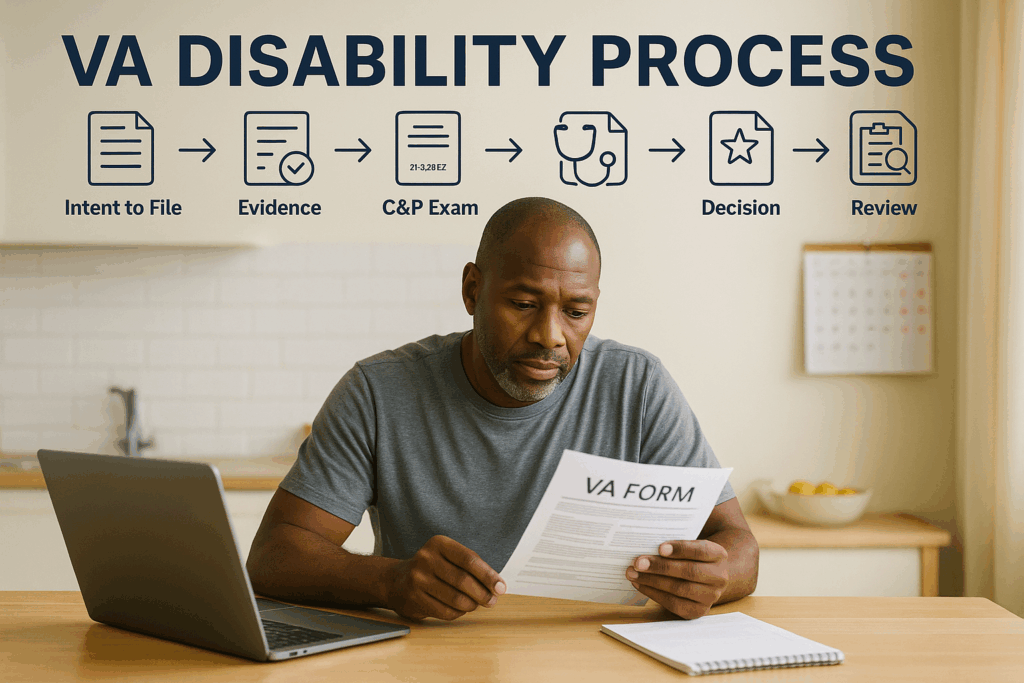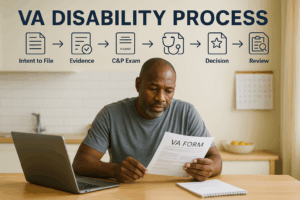VA Disability Claims
Introduction: What This Guide Will Help You Do
Filing a VA disability claim can feel confusing. The rules are dense, the forms are formal, and the process takes time. This guide strips it down to the essentials. You’ll see what to do, when to do it, and why it matters—from Intent to File and medical evidence to the C&P exam, decisions, ratings, and how to challenge a bad result.
Everything here is based on current VA guidance and forms. You’ll also see links to official VA pages so you can verify details or act right away. Veterans Affairs+2Veterans Affairs+2
Quick Overview: The VA Disability Claim In 7 Steps
- Confirm eligibility and decide what you’re claiming.
- Secure your earliest pay date: submit an Intent to File (VA Form 21-0966). Veterans Affairs+1
- Gather evidence: service records, medical records, lay statements.
- File your claim with VA Form 21-526EZ (online, by mail, or in person). Veterans Affairs+2Veterans Affairs+2
- Complete your C&P exam if VA schedules one. Veterans Affairs
- Track status and wait for the decision (typical timelines vary month to month). Veterans Affairs
- Read the decision letter; if it’s wrong or incomplete, pick a decision review option (Higher-Level Review, Supplemental Claim, or Board Appeal). Veterans Affairs+2Veterans Affairs+2
Who’s Eligible (In Plain English)
You may qualify for tax-free compensation if:
- You served on active duty, active duty for training, or inactive duty training, and
- You have a current disability that is connected to your service (directly, aggravated by service, or secondary to another service-connected disability). Veterans Affairs
Important: You don’t need a combat injury to qualify. Training injuries, exposure, or conditions that developed after service can also be service-connected if the evidence supports the link.
Step 1: Lock In Your “Start Date” With An Intent To File
Submitting an Intent to File tells VA you plan to file a claim and protects your potential effective date (the date VA can start your retroactive pay), if you send the full claim within one year. You can do this online, by phone, or by paper form (VA Form 21-0966). Veterans Affairs+2Veterans Affairs+2
- Online or phone: Fastest ways to mark your intent.
- Paper: Mail VA Form 21-0966; the form makes clear it’s not a claim—your full application must follow. VBA
Why this matters: The effective date affects back pay. Filing within one year of separation can set an effective date as early as the day after you left service. Veterans Affairs
Step 2: Build A Strong Evidence File
Think like a reviewer who never met you. Give them clean, credible proof.
Core evidence types
- Medical evidence: Diagnoses, treatment notes, test results.
- Service records: Incidents, duty assignments, exposures.
- Nexus evidence: A medical opinion connecting your condition to service (or to a service-connected condition).
- Lay statements: From you or others who can describe symptoms, onset, and impact in daily life.
Tips for stronger files
- Timeline: Write a simple one-page timeline of symptoms, treatment, and duty locations.
- DBQs: If appropriate, your provider can refer to Disability Benefits Questionnaires (DBQs) aligned with your conditions. Veterans Affairs
- Be consistent: Your statements, medical notes, and service records should tell the same story.
Step 3: File The Claim (VA Form 21-526EZ)
You can file online, by mail, or in person:
- Online (recommended): Guided workflow on VA.gov.
- Mail: Send VA Form 21-526EZ to the Claims Intake Center, PO Box 4444, Janesville, WI 53547-4444.
- In person: Bring your application to a VA regional office. Veterans Affairs+1
What to include
- The conditions you’re claiming.
- Evidence you already have (upload copies; keep originals).
- Names of providers and facilities so VA can request records.
- Clear lay statement describing what happened, when, symptoms, and impact on work and daily life.
Pro tip: Use your Intent to File window wisely. Submit the complete claim with well-organized evidence inside that one-year period so you don’t lose the earlier effective date. Veterans Affairs
Need Help Filing Your Claim?
We at Absolute Support can Guide you Through the Process.
Get Your Claim Started?Step 4: Prepare For Your C&P Exam
Many claims require a Compensation & Pension (C&P) exam. It’s not treatment; it’s an evaluation. Here’s what typically happens:
- The examiner reviews your file and may perform a targeted exam.
- You’ll answer questions tied to the DBQ for your condition.
- You may be sent for tests (X-ray, labs) at no cost to you. Veterans Affairs
How to do well—without oversharing
- Be honest and specific about your worst days and typical days.
- Describe function (standing, lifting, sitting, concentration, sleep).
- Don’t minimize: If it hurts, say so. If it limits you, explain how.
- Bring a list: Symptoms, meds, and any flare patterns.
Myth check: Examiners don’t decide your claim. They document findings; VA adjudicators decide using all the evidence. VA News
Step 5: Track Your Claim And Understand Timelines
VA posts the average days to complete disability claims each month. This number moves; for example, it was 94.8 days in August 2025. Your case can be faster or slower based on evidence needs, exams, and complexity. Veterans Affairs
Where to check status
Log in to VA.gov to see updates, respond to requests, and upload evidence.
Step 6: Your Decision Letter, Rating, And Effective Date
Your decision letter explains:
- Service connection (granted or not)
- Disability rating (0–100% in 10% steps)
- Effective date (the start date VA uses to pay you)
- Reasons and evidence considered
- What happens next
About effective dates
In general, VA uses the later of (1) the date VA got your claim, or (2) the date entitlement arose. If VA gets your claim within one year of separation, the effective date can be the day after you left active service. An Intent to File can also protect retroactive pay if you submit the full claim within a year. Veterans Affairs+1
Step 7: If You Disagree—Know Your Review Options
You have several decision review lanes. Pick the one that fits your situation:
1) Higher-Level Review (HLR)
Ask a more senior reviewer to re-look your case. No new evidence, but you can point out errors and request an informal conference (note: that may add time). VA’s stated goal for many non-health benefits reviews is around 125 days, but actual times vary. Veterans Affairs
2) Supplemental Claim
Submit new and relevant evidence (e.g., new medical opinion, service record). You can file a Supplemental Claim any time, but submitting within one year preserves continuous review rights. Veterans Affairs
3) Board Appeal
Go to the Board of Veterans’ Appeals. Choose a lane: Direct Review, Evidence Submission, or Hearing. The Board’s goal for many cases is about 550 days (varies by lane and docket). Veterans Affairs
Deadline basics
For most benefits, you have one year from the decision letter to request HLR or Board Appeal. Your letter lists your exact deadline. Veterans Affairs
Common Mistakes That Slow (Or Sink) Claims
- Skipping the Intent to File and losing months of back pay. Veterans Affairs
- Vague statements that don’t explain how symptoms limit daily life or work.
- Missing exams: If VA sets a C&P, go or reschedule early. Veterans Affairs
- Assuming VA will gather everything: Give VA complete provider info and upload strong copies yourself. Veterans Affairs
- Not reading the letter: Your decision letter tells you why VA decided as it did—use it to guide HLR or a Supplemental Claim. Veterans Affairs
What “Good” Evidence Looks Like (Examples You Can Copy)
For back pain (secondary to knee)
- Nexus: A clinician explains how altered gait from your knee condition increased lumbar strain, citing records.
- Function: “I can stand 10 minutes, lift 10 lbs, sit 30 minutes before pain spikes to 7/10; I miss 2 days/month.”
- Consistency: Statements match PT notes and imaging.
For migraines
- Frequency: “3 prostrating migraines/month, lasting 6–12 hours; I must lie in a dark room.”
- Impact: Missed shifts, accommodations, ER visits—show dates.
For PTSD
- Stressors: Identify incidents, dates, unit/location.
- Treatment evidence: Diagnoses, therapy notes, symptom tracking.
- Lay evidence: Spouse or coworker statements noting changes in sleep, anger, concentration.
Timelines: What To Expect (Typical, Not Guaranteed)
- Initial claim: VA publishes monthly averages (recent example: ~95 days). Your case may be shorter or longer depending on exams and evidence. Veterans Affairs
- Higher-Level Review: Goal often ~125 days; adding an informal conference can lengthen it. Veterans Affairs
- Board Appeal: Goal around 550 days, lane-dependent. Veterans Affairs
Bottom line: Submit clean evidence, answer VA requests fast, and go to your exams. That’s what you control.
How Payment Amounts Are Decided
VA uses your combined disability rating (0–100%) and your dependents to set your monthly, tax-free payment. The rating is based on severity and function under VA’s rating schedule. Your decision letter will list each condition, the percent, and the rationale. Veterans Affairs
Frequently Asked Questions
Do I need a VSO or attorney?
No, but they can help. Accredited Veterans Service Organizations (VSOs) file claims for free. Some attorneys or agents work on appeals on a contingency basis.
Should I wait until I have every record before filing?
No. File an Intent to File now to protect your date, then gather and submit. Veterans Affairs
What if I miss a C&P exam?
Tell VA early if you need to reschedule. Missing it can lead to a denial for lack of evidence. Veterans Affairs
What if my condition gets worse later?
File for an increase with new evidence (treatment notes, employer statements, updated diagnostics). Veterans Affairs
How do effective dates work?
Generally the later of (1) when VA got your claim or (2) when entitlement arose. Special rules apply if you file within one year of separation. Veterans Affairs
Action Checklist (Print This)
- Today
- Submit Intent to File online or by calling 800-827-1000. Veterans Affairs
- Start a one-page timeline of symptoms and treatment.
- This Week
- Request copies of key medical and service records.
- Ask your provider if they can address a nexus in their notes.
- Within 30 Days
- Draft your lay statement (plain, specific).
- File VA Form 21-526EZ online with organized uploads. Veterans Affairs
- After Filing
- Attend any C&P exam; bring your symptom list. Veterans Affairs
- Check VA.gov for messages; respond quickly.
- When You Get The Letter
- If granted, confirm rating and effective date are right. Veterans Affairs
- If wrong, pick HLR, Supplemental, or Board Appeal—note the one-year clock. Veterans Affairs
![Suggested image: A simple flowchart graphic: Intent to File → Evidence → 21-526EZ → C&P Exam → Decision → (Optional) Review. Alt text: “VA disability process flow.”]
Helpful Links (Official VA)
- Start/How to file (online, mail, in person) and Form 21-526EZ. Veterans Affairs+1
- Intent to File overview, online submission, and Form 21-0966. VBA+3Veterans Affairs+3Veterans Affairs+3
- C&P exam: what to expect and how to prepare. Veterans Affairs+1
- After you file: current average timelines. Veterans Affairs
- Effective dates explained. Veterans Affairs
- Decision reviews: HLR, Supplemental Claim, Board Appeal, deadlines. Veterans Affairs+2Veterans Affairs+2
Conclusion & Next Step
You don’t have to memorize the rulebook to win a VA disability claim. You need a protected date, clear evidence, honest exams, and a plan if the decision misses the mark.
Do this now:
- File your Intent to File to lock in your date. 2) Map your evidence and write a clean lay statement. 3) File 21-526EZ with organized uploads. If your letter isn’t right, use decision review—don’t give up your benefits.
If you’d like, I can turn this checklist into a printable one-pager and a simple claim-tracker spreadsheet.







